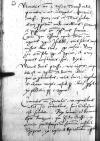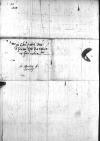Quid rerum ⌊hic⌋ egerit vir iste ambitiosus, non sane scio. Visus est mihi raro ad ⌊principum⌋ conspectum venisse. Apud ⌊dominam nostram⌋ rarissime idque non alia de causa, quod quidem ego sciam, nisi ut talleros, ducatos et argentum, si venalia ⌊istic⌋ essent, coemeret pro pecunia dominae nostrae, qua ille multum abundat. Ille tamen id secrete aget, si modo secreto fieri ab illo possit. Quid autem cum ⌊rege⌋ egerit, nescio. Credo, si quid eiusmodi est alicuius momenti, id vel reverendissimus dominus ⌊vicecancellarius⌋ aut ⌊Osius⌋ proscribet Reverendissimae Dominationi Vestrae. Iam ego nunc, nescio qua pigritia, istarum rerum investigandarum curiosus esse desii.
Hoc etiam apud nos canonicos in ⌊capitulo⌋ nostro egit. Oravit sibi solvi per nos mille plus minus florenos, quos ei defunctus ⌊archiepiscopus⌋ pro panno, pro vitro debebat. Cui ad 1546-06-24⌊festum sancti Ioannis Baptistae1546-06-24⌋ diximus solutionem, modo sit, unde id fiat.
⌊Nuntius⌋ noster a ⌊caesare Turcorum⌋ rediit. Privatim a me interrogatus narravit mihi pacem nos cum ⌊Turcis⌋ habere, etiam perpetuam, modo vellemus, sciremus et possemus eam ipsi nos servare. Ceterum, quae confecerit apud ⌊Turcum⌋ in negotiis ⌊reginae Isabellae⌋, cuius solius caus[a] missus ⌊illuc⌋ erat, ego nescio. Nam haec coram solo ⌊rege⌋ et ⌊regina⌋ et coram paucis consiliariis ⌊hic⌋ dixit.
Monetae ⌊ducis Prussiae⌋ vis ingens imp[or]tata est in ⌊Regnum⌋ et dominia illius. Quae a probatoribus veluti levior improbat[a] et idcirco receptio ususque illius prohibet[ur] explodeturque e ⌊Regno⌋.
⌊Conventus noster generalis⌋ magnatibus nostris sic cudentibus sine conclusione est solutus. ⌊Rex⌋ tamen cum domini[s] episcopis dumtaxat pro praesidio ⌊Russiae⌋ ex amore pacis, pauperum hominum, instituit czopowe ex regiis et spiritualium oppid[is] et insuper rex litteras restium primarum et secundarum ad omnes terras misit, ut sint omnes parati et instructi ad bellum, si quod undecumque eveniret.
⌊Oratores⌋ ⌊regis Ferdinandi⌋ iverunt ad ⌊regem iuvenem⌋ in ⌊Lithuaniam⌋ repetitum ab illius maiestate thesauros, argentum, clenodia et mundum muliebrem ⌊reginae Elisabetae⌋ defunctae. ⌊Germani⌋ haec multis computant milibus, sed non est ita. Credo, quod ⌊rex⌋ haec non gravatim restituet. De nova nupta, quae aut unde erit, nihil dicitur, nihil auditur nec homines nostri quidquam de hoc dicunt.
⌊Principes⌋ nostri sunt, Deo sit gratia, recte salvi et incolumes.
Bene et feliciter valeat Dominatio Vestra Reverendissima. Cui me et obsequia mea dedo et devoveo.



